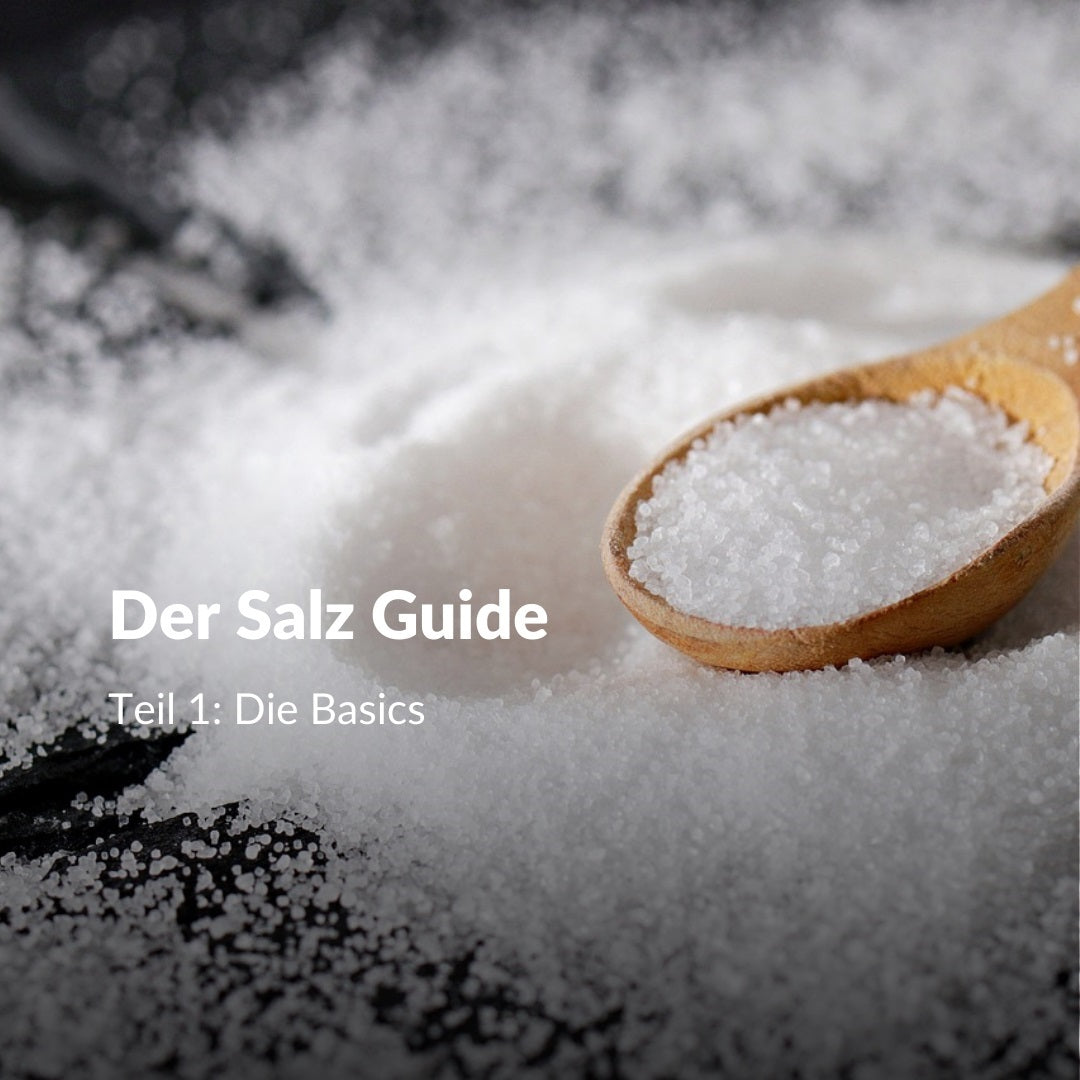
Der Salz Guide: Teil 1 - Die Grundlagen
Salz gehört zu den grundlegendsten Elementen beim Kochen. Es verstärkt Aromen, konserviert Lebensmittel und spielt eine wichtige Rolle in unserer Ernährung. Aber nicht jedes Salz ist gleich. Die Wahl des richtigen Salzes kann einen grossen Einfluss auf den Geschmack, die Textur und die Präsentation deiner Gerichte haben. In diesem ersten Teil unserer dreiteiligen Serie tauchen wir in die Grundlagen des Salzes ein und erkunden seine verschiedenen Formen, Ursprünge und Anwendungen.
Inhaltsverzeichnis
Disclaimer Wir beziehen uns auf die gesundheitlichen Aspekte des Salzkonsums und die biologischen Mechanismen, in denen Salz eine Rolle spielt. Wir sind jedoch keine Experten und geben keine Empfehlungen, wie du ein gesundes Leben führen solltest. Stelle sicher, dass du Fakten überprüfst und Experten wie Apotheker oder Ärzte konsultierst, und recherchiere selbst. Ende des Disclaimers
Was ist Salz?
Im Kern ist Salz ein Mineral, das hauptsächlich aus Natriumchlorid (NaCl) besteht und lebensnotwendig ist. Es kommt natürlich in Meerwasser vor oder wird aus alten Ablagerungen abgebaut, die durch die Verdunstung prähistorischer Meere entstanden sind. In fast jeder Kultur der Welt ist Salz ein unverzichtbarer Bestandteil der Ernährung, mit ebenso vielen Spezialtypen. Seine Rolle bei der Konservierung und Verstärkung natürlicher Aromen hat es zu einem Grundpfeiler der kulinarischen Traditionen seit den Anfängen der Menschheitsgeschichte gemacht.

Eine kurze Geschichte des Salzes
Salz hat eine faszinierende Geschichte, die Jahrtausende umspannt. Es war einst so wertvoll, dass es in einigen Teilen der Welt als Währung verwendet wurde. Alte Zivilisationen wie die Ägypter, Römer und Chinesen handelten Salz über weite Entfernungen und legten damit den Grundstein für das, was wir heute die „Salzstrassen“ nennen. Über Jahrhunderte hinweg war Salz ein Schlüsselprodukt im Handel und spielte sogar eine Rolle in der politischen Macht, wobei ganze Städte um Salzproduktionsstätten herum entstanden sind.
Bevor Kühlung weit verbreitet war, war Salz entscheidend, um verderbliche Waren wie Fleisch, Fisch und Gemüse zu konservieren. Durch das Entziehen von Feuchtigkeit mittels Osmose verhinderte Salz das Wachstum von Bakterien und verlängerte die Haltbarkeit von Lebensmitteln. Diese Praxis wird auch heute noch mit gepökeltem Fleisch, gesalzenem Fisch und eingelegtem Gemüse angewendet – zeitlose Techniken, die die konservierende Kraft des Salzes unter Beweis stellen. In den richtigen Verhältnissen kann diese Fermentierung nicht nur Lebensmittel erhalten, sondern auch unglaubliche Aromen und den charakteristischen „Funk“ erzeugen – die Milchsäurebakterien (Lactobacillus acidophilus) gedeihen in einer leicht salzigen Umgebung und zersetzen Lebensmittel auf eine sichere Weise – ein Prozess, den wir bei unseren Hot Sauces zur Kunstform erhoben haben.
Die Wissenschaft hinter Salz
Das Hauptelement von Salz, Natriumchlorid (NaCl), ist eine ionische Verbindung, die eine entscheidende Rolle in verschiedenen biologischen und chemischen Prozessen spielt. Beim Kochen interagiert Salz auf molekularer Ebene mit Lebensmitteln, verstärkt Aromen und verändert Texturen. Ein wesentlicher Prozess, den Salz auslöst, ist die Osmose , bei der Feuchtigkeit aus Lebensmitteln gezogen wird, was es zu einem ausgezeichneten Konservierungsmittel macht.
Salz spielt auch eine Rolle bei der Geschmacksverstärkung, indem es Geschmacksknospen auf unserer Zunge stimuliert und andere Aromen ausbalanciert. Es kann die Süsse in Desserts intensivieren oder die Bitterkeit von Gemüse wie Grünkohl oder Radicchio abmildern. Richtig eingesetzt verstärkt Salz die Komplexität eines Gerichts und macht es zu einer unverzichtbaren Zutat für jeden Koch.
Warum wir Salz brauchen
Salz ist nicht nur ein Geschmacksverstärker – es ist auch entscheidend für die Gesundheit. Natrium, einer der Hauptbestandteile von Salz, hilft bei der Regulierung des Blutdrucks, der Aufrechterhaltung des Flüssigkeitshaushalts und der Unterstützung der Nerven- und Muskelfunktion. Da der Körper Natrium nicht selbst produzieren kann, muss es über die Nahrung aufgenommen werden.
Dennoch ist es wichtig, das richtige Gleichgewicht zu finden. Zu wenig Salz kann zu Muskelkrämpfen, Müdigkeit und Blutdruckproblemen führen, während zu viel Salz mit Bluthochdruck und anderen Herz-Kreislauf-Problemen in Verbindung gebracht wird. Das richtige Mass zu finden, ist entscheidend, um sowohl dein Essen als auch deine Gesundheit in Harmonie zu halten.
Arten von Salz: Eine Welt voller Unterschiede
Bei der Wahl des Salzes für deine Küche gibt es eine breite Auswahl an Möglichkeiten, jede mit ihrem eigenen einzigartigen Geschmacksprofil und ihrer eigenen Textur. Schauen wir uns ein paar wichtige Salztypen an, darunter einige, die wir bei Gipfelhirsch anbieten, sowie andere bemerkenswerte Varianten:
Meersalze
Meersalz, auch bekannt als marines Salz oder einfach Salz, wird durch Verdunstung von Meerwasser gewonnen. Diese Salzart enthält Spurenelemente, die ihm einen komplexeren Geschmack als raffiniertes Tafelsalz verleihen. Meersalze variieren in der Textur, von fein bis grob, und umfassen Sorten wie Fleur de Sel und grobes Meersalz. Sie eignen sich hervorragend zum Verfeinern von Gerichten und stammen aus verschiedenen Regionen, wie dem Mittelmeer und der Atlantikküste, von der Nordsee bis zum Pazifik. Einige dieser Salze werden in grossen Maschinen produziert, die chemisch reines Salz extrahieren und es im Wesentlichen zu einem Tafelsalz oder koscheren Salz machen (dazu später mehr). Andere werden von Hand durch die Verdunstung von Meerwasser in grossen Becken in Meeresnähe gewonnen.
Grobes Meersalz
Feines Meersalz
Fleur de Sel
Flockensalz - auch bekannt als Fleur de Sel-Pyramiden
Steinsalze
Koscher-Salz
Himalaya-Salz (rosa)

Besondere Salze
Geräuchertes Himalaya-Salz
Schwarzes Lava-Salz
Rotes Hawaiianisches Salz (Alaea-Salz)


